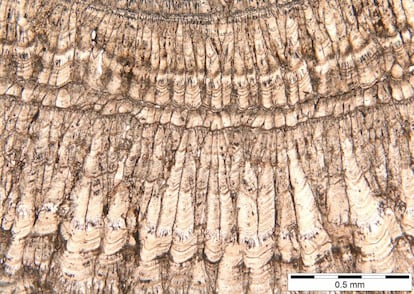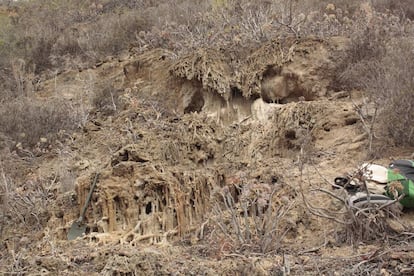The curious Canary Islands rock formation that took just decades to settle
A chance discovery on Gran Canaria has captured the attention of scientists, who believe that this “mini Pamukkale” was formed thanks to an old rudimentary irrigation system

Spanish scientists have found a unique rock formation in a rugged region to the north of the Canary Island of Gran Canaria, close to the Cenobio de Valerón archeological dig.
In the Calabozo gulley, calcite sediment has been deposited in a series of pools and waterfalls which have since dried up but which would have been reminiscent of the white terraces in Pamukkale, Turkey, or the Ruidera lakes on the Iberian Peninsula in their day. But while Pamukkale and Ruidera were formed over hundreds of thousands of years, the Calabozo formation took less than three decades.
On these volcanic islands, the subterranean water is rich in bicarbonate, calcium, magnesium, sodium, silicon and carbon dioxide
Toward the end of the last century, the banana plantations on the Canary Islands were irrigated with water from wells and tunnels. But before a modern irrigation system was installed, water was extracted from high hilly ground and ran downward in basic pipes until reaching the plantations below.
On these volcanic islands, the subterranean water is rich in bicarbonate, calcium, magnesium, sodium, silicon and carbon dioxide. And so it leaves a trail of calcite sediment and other minerals in its wake. It was this geological process, accelerated by the irrigation system, that produced the ultra rapid formation in Calabozo, which is 20 meters high and 10 meters across.
The research team, consisting of four geologists from the Complutense University of Madrid (UCM), the Institute of Geoscience (UCM-CSIC) and Las Palmas University, has been studying the phenomenon for the past seven years and has just published an article on their work in the scientific journal Sedimentology, and which appears on the front cover of the latest edition.

However, it was not in fact a scientist who discovered the formation in Calabozo, according to Ana María Alonso, president of the Spanish Geological Society and co-author of the piece. The society organizes an annual workshop known as “Geoloday” and, during one such event in 2010, a participant told the organizers about the existence of “some very strange stones.”
“I’m very enthusiastic,” says Alonso. “When I saw it for the first time in 2011, I thought, ‘This is like a mini Pamukkale!’ But it’s prettier because there are no calcified plants in Pamukkale.”
The formation in Calaboza is distinctive because rocks crystallized around the tangled vegetation that grows on the hillside. This kind of sediment is known as tuff. The plants die and decompose but the calcified casing lasts.

The scientists believe that the Calabozo formation was formed between the 1950s and the 1980s, a conclusion they reached by somewhat unorthodox means. Within the tuff, they found a small stone shaped like a potato that contained a ball of polystyrene. Like any other rock nucleus, it offered a vital clue. “We looked into when polystyrene was first made in Spain. It was in 1951, so the Calaboza system had to have been formed after that,” explains Alonso. An analysis of the material used in the construction of the old irrigation pipes substantiates the estimate.
Alonso says the discovery is of value in two ways. On the one hand, it shows that deposits can be crystallized very quickly when the landscape is modified by humans – a process that contributes to geological diversity. “Informatively, it helps us to know more about the formations on the Canary Islands,” says Alonso. “These islands are volcanic and there is not usually any calcite.”
On the other hand, the detailed analysis has enabled scientists to see how the presence or absence of water can affect the texture and chemical composition of the mineral sediment. “Our knowledge of this within a recent system enables us to understand similar older systems,” says Alonso. “The changes to the texture and chemistry [of the sediments] can help us to understand the past climate, for example.”
The formation in Calaboza is distinctive because rocks crystallized around the tangled vegetation that grows on the hillside
As mineral deposits only form when there is a flow of water, there are different kinds of calcareous lamination in the gulley, depending on whether the irrigation was being used or not.
The geologists can see different sized crystals in the tuff, for example, that correspond to the periods of suspension in the irrigation, depending on whether these lasted hours or days or entire seasons or years. “It has been a challenge to get our heads around this because we are used to working with deposits that take hundreds or thousands of years to form,” says Alonso. “But now we know how it works, we can look for similar processes in other natural systems.”
Since the research was finished in the Calabozo gulley, Alonso’s team has found other similar sediments on another Canary Island, Tenerife, and they believe there are still more waiting to be discovered.
English version by Heather Galloway.
Tu suscripción se está usando en otro dispositivo
¿Quieres añadir otro usuario a tu suscripción?
Si continúas leyendo en este dispositivo, no se podrá leer en el otro.
FlechaTu suscripción se está usando en otro dispositivo y solo puedes acceder a EL PAÍS desde un dispositivo a la vez.
Si quieres compartir tu cuenta, cambia tu suscripción a la modalidad Premium, así podrás añadir otro usuario. Cada uno accederá con su propia cuenta de email, lo que os permitirá personalizar vuestra experiencia en EL PAÍS.
¿Tienes una suscripción de empresa? Accede aquí para contratar más cuentas.
En el caso de no saber quién está usando tu cuenta, te recomendamos cambiar tu contraseña aquí.
Si decides continuar compartiendo tu cuenta, este mensaje se mostrará en tu dispositivo y en el de la otra persona que está usando tu cuenta de forma indefinida, afectando a tu experiencia de lectura. Puedes consultar aquí los términos y condiciones de la suscripción digital.
More information
Últimas noticias
Most viewed
- Alain Aspect, Nobel laureate in physics: ‘Einstein was so smart that he would have had to recognize quantum entanglement’
- The US bombing of Venezuela, in pictures
- Oil, gold and rare earth elements: the backdrop to US political tension with Venezuela
- Maps of the US attack on Venezuela: Targets, airspace and deployed fleet
- Delta Force, the elite US military unit that captured Maduro









































